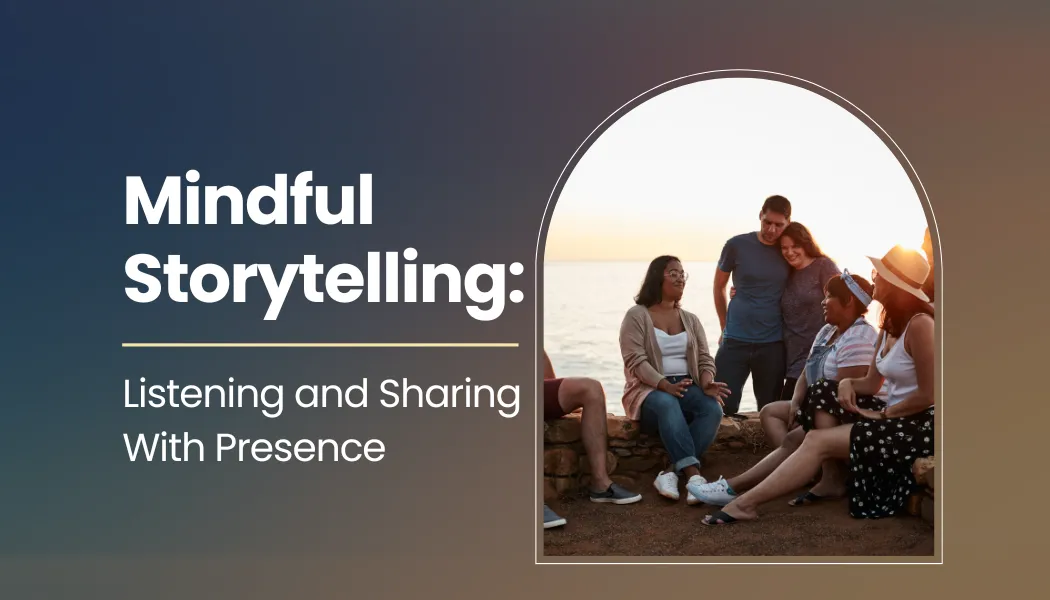Storytelling is as old as humanity itself. From the cave paintings of early civilizations to the novels, films, podcasts, and bedtime stories of today, storytelling has been our way of understanding the world and each other. But in our fast-paced, distraction-filled era, the way we tell and listen to stories has shifted. Too often, stories are rushed, reduced to soundbites, or drowned out by noise. Mindful storytelling offers us a way back—a practice of sharing with presence, of listening with the full heart, and of creating deeper human connections through words.
In this article, we will explore what mindful storytelling means, why it matters in today’s world, how it can be practiced both in speaking and listening, and how it impacts relationships, education, therapy, leadership, and even our personal growth. Through practical techniques, inspiring examples, and reflections, we will uncover how mindful storytelling can transform not only the stories we tell but also the way we live.
Table of contents
- The Ancient Power of Storytelling
- What Is Mindful Storytelling?
- The Role of Listening in Mindful Storytelling
- The Healing Power of Mindful Storytelling
- Mindful Storytelling in Daily Life
- Practical Techniques for Mindful Storytelling
- Mindful Storytelling in Education
- Storytelling as Leadership
- Storytelling in the Digital Age
- Cultural Storytelling and Mindfulness
- Challenges in Practicing Mindful Storytelling
- The Personal Growth of Storytelling
- Conclusion: Living as a Story
The Ancient Power of Storytelling
Before books, films, and social media, stories were passed orally from generation to generation. These tales carried wisdom, preserved traditions, and fostered community. They were not only about entertainment but about survival, guidance, and shared meaning. Around campfires, people listened with reverence, allowing the storyteller’s words to shape their imagination and understanding.
In traditional cultures, storytelling was inseparable from mindfulness. The act of telling a story required presence—tone, rhythm, pauses, and gestures mattered. The act of listening demanded patience and openness, as stories often carried layers of meaning revealed over time.
Today, we often consume stories in fragments, skimming headlines or half-listening while multitasking. Mindful storytelling reminds us that stories deserve—and require—our presence. Whether we are narrating our own experiences or listening to others, slowing down to truly engage with the story allows us to reconnect with this ancient practice in a meaningful way.
What Is Mindful Storytelling?
Mindful storytelling is more than simply telling a story. It is storytelling that arises from awareness, compassion, and presence. It is the intentional practice of sharing stories in a way that honors both the teller and the listener.
At its core, mindful storytelling involves:
- Presence: Being fully engaged in the moment while telling or listening to a story.
- Awareness: Noticing emotions, body language, and subtle cues—both in ourselves and others.
- Compassion: Holding the story and the storyteller with kindness, without judgment.
- Connection: Using stories as bridges that connect people beyond surface-level interactions.
It differs from performance-driven storytelling, which often focuses on impressing or entertaining. Mindful storytelling, instead, is relational—it emphasizes authenticity, empathy, and resonance.
The Role of Listening in Mindful Storytelling
One of the most overlooked aspects of storytelling is listening. A story cannot truly exist without a listener. Too often, we listen only to reply, not to understand. Mindful listening transforms this dynamic.
Mindful listening means:
- Putting aside distractions and giving full attention to the speaker.
- Listening not just to words, but to tone, pauses, and emotions.
- Allowing silence without rushing to fill it.
- Letting go of the need to judge, fix, or interrupt.
When we listen mindfully, we create a safe container for the storyteller. This presence encourages them to share more openly and deeply. Listening becomes an act of love, and stories become vehicles of healing and connection.
The Healing Power of Mindful Storytelling
Stories have always had the power to heal. From the myths that helped ancient people make sense of loss, to modern-day therapy that uses narrative techniques, storytelling helps us process emotions and find meaning in suffering.

Mindful storytelling amplifies this healing potential. When someone shares their trauma, grief, or struggle in a mindful space, they are not just recounting facts—they are integrating their experience. The presence of a mindful listener validates their journey.
For example, survivors of illness or hardship often speak of how telling their story helps them reclaim agency. Meanwhile, listeners who approach with empathy often find that the story expands their own compassion and perspective. This mutual transformation is what makes mindful storytelling so powerful in therapeutic settings, support groups, and even casual conversations.
Mindful Storytelling in Daily Life
You don’t need to be a professional storyteller or therapist to practice mindful storytelling. It can be woven into everyday life:
- At the dinner table: Instead of rushing through, invite each person to share one meaningful story from their day. Listen without interruption.
- With children: Practice bedtime storytelling with presence. Allow the child’s questions and imagination to guide the story’s flow.
- At work: In meetings, use storytelling not just for presentations but for building team trust—share stories of challenges, successes, and lessons learned.
- With friends: Instead of small talk, ask open-ended questions that invite deeper stories, like “What’s a moment that shaped you recently?”
Each of these moments becomes richer when infused with mindfulness—slowing down, listening deeply, and responding with presence.
Practical Techniques for Mindful Storytelling
If you want to practice mindful storytelling, here are some simple techniques:
As a Storyteller:
- Ground yourself: Take a few breaths before sharing to arrive fully in the moment.
- Speak from the heart: Share honestly rather than trying to impress.
- Use pauses: Allow silence—it helps the listener absorb the story.
- Notice body language: Stay aware of how your body communicates as much as your words.
- Respect boundaries: Share only what feels safe, and honor the weight of your own story.
As a Listener:
- Set aside distractions: Put down your phone or other tasks.
- Maintain eye contact: Show attentiveness through presence.
- Listen without judgment: Avoid correcting or dismissing the storyteller.
- Reflect back: Acknowledge what you heard, e.g., “It sounds like that was really difficult for you.”
- Hold space: Sometimes, silence is the most supportive response.
Over time, these practices become natural, deepening our ability to both tell and receive stories.
Mindful Storytelling in Education
Teachers have long used stories to inspire, teach values, and bring lessons to life. Mindful storytelling in education takes this further. When educators tell stories with presence, students not only absorb knowledge but also connect emotionally.
For example, a history teacher might not just list dates but tell the story of a child who lived during that time. A science teacher might share a personal story of discovery or failure. These mindful stories stick with students because they resonate on a human level.
Equally important, when students are invited to tell their own stories in a mindful environment, they feel seen and valued. This builds confidence, empathy among peers, and deeper engagement with learning.
Storytelling as Leadership
Great leaders are often great storytellers. They inspire teams not by reciting statistics, but by telling stories that create vision, meaning, and connection. Mindful storytelling in leadership is about authenticity—sharing not only successes but also struggles.
When leaders share mindfully, they create trust. Employees feel more connected and motivated when they understand the human story behind decisions. Likewise, mindful listening helps leaders better understand the stories of their teams, making them more responsive and compassionate.
This shift from transactional communication to mindful storytelling transforms workplaces into communities of purpose and belonging.
Storytelling in the Digital Age
Social media and digital platforms have transformed how we share stories. On one hand, they’ve democratized storytelling—anyone can share their story with the world. On the other, the speed and brevity of digital platforms often dilute mindfulness.
Practicing mindful storytelling online might mean:
- Sharing stories with intention, not just for likes or attention.
- Being authentic instead of curating perfection.
- Taking time to engage deeply with others’ stories instead of scrolling past.
Even in digital spaces, presence and compassion are possible—and necessary—for storytelling to retain its depth.
Cultural Storytelling and Mindfulness
Different cultures have unique traditions of storytelling, from Native American oral histories to African griot traditions to Asian parables. Mindful storytelling honors these traditions by approaching them with respect and presence.
Listening to cultural stories mindfully allows us to appreciate not only the content but also the worldview and wisdom embedded within them. Sharing our own cultural stories mindfully fosters pride and connection, while also creating space for dialogue and mutual understanding.
Challenges in Practicing Mindful Storytelling
While mindful storytelling sounds simple, there are challenges:
- Distractions: In a busy world, giving full attention can feel difficult.
- Vulnerability: Sharing stories honestly can feel risky.
- Impatience: Listeners may want quick points instead of slow unfolding.
- Bias: Listeners may interpret stories through their own judgments.

Acknowledging these challenges is part of the practice. Mindfulness means noticing when distractions or judgments arise and gently returning to presence. Over time, this becomes easier.
The Personal Growth of Storytelling
On a personal level, practicing mindful storytelling deepens self-awareness. Telling our own stories mindfully allows us to see patterns, values, and lessons we might have missed. Journaling, for example, is a form of self-storytelling that can bring clarity and healing.
Listening mindfully to others’ stories broadens our empathy and understanding. We begin to see the world not just from our own lens but from multiple perspectives. This cultivates compassion, humility, and connection.
Conclusion: Living as a Story
Ultimately, mindful storytelling is not just about telling or listening—it is about living. Our lives themselves are unfolding stories. When we approach them mindfully, we become more present authors of our own narratives. We learn to honor not only the stories we tell but also the ones we live each day.
In a world where attention is fragmented and stories are often rushed, mindful storytelling invites us to slow down. It calls us to listen deeply, speak authentically, and share with presence. It reminds us that stories are not just words—they are bridges of connection, healing, and meaning.
So the next time someone begins to share a story, take a breath, set aside distractions, and truly listen. And when you tell your own story, speak not just with words but with presence. In these mindful moments, storytelling becomes what it was always meant to be: a shared act of humanity, rich with compassion, connection, and awareness.
